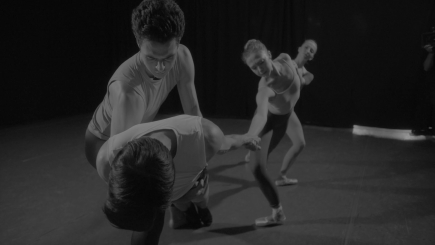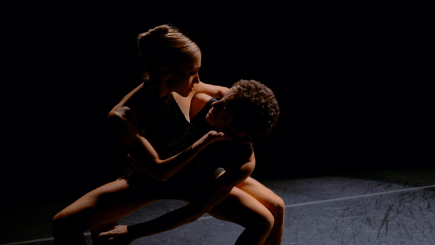Online
November 23, 2020
David Mead
ABT Today: The Future Starts Now features four new works all created and filmed in quarantined ballet bubbles at locations in upstate New York and Connecticut. The streaming also marks the public launch of ABT RISE (Representation and Inclusion Sustain Excellence), which is aimed at advancing ABT’s diversity, equity, and inclusion efforts. Nodding in that direction, there the choreographers are two white women (Gemma Bond and Pam Tanowitz) and two black men (Christopher Rudd and Darrell Grand Moultrie). In another sign of new thinking, each ballet begins with a written acknowledgment that it was filmed on land forcefully taken from indigenous peoples.
Best of the bunch (just) is Christopher Rudd’s Touché, filmed in a small black box theatre at the Silver Bay YMCA in upstate New York. Set to music by Woodkid from the film Desierto, and Ennio Morricone’s Giuseppe Tornatore Suite, it’s an intimate duet for Calvin Royal III and João Menegussi, Rudd explains in an introduction that it’s an effort “to normalize gay love and lust.” It’s not just beautiful, it’s sensational; a work run through with deep emotional honesty that comes through in every second.

Photo Matador Content
An unapologetic depiction of male love, Touché starts with the couple back to back. They hold their throats as if being strangled by society’s unwillingness to accept them as they are. As they come together, Rudd first shows us their shame and secrecy, their uncertainty and internal battles. The choreography makes the most of the men’s physical strength in some innovative partnering, but also their vulnerability.
About six minutes in, close-up, face to face and in silence, the dancers do little other than look at each other as they strip to their briefs. It’s slow, classy and utterly compelling. It speaks volumes. The tender pas de deux that follows is exquisite, and ends with a kiss. It is completely transfixing.
Shot in the same space, former ABT and Royal Ballet dancer Gemma Bond’s Convivium, her second work for ABT shows a quartet of dancers coming to terms with being together in the same space once more. Despite sharing the same stage, the choreography and the black box itself conjures up a feeling of emotional isolation. Set to Variations for Clarinet, Violin, and Piano by John Harbison, there is an overwhelming sense of them treading carefully with each other, exemplified by the way Thomas Forster takes the hands of the other three, pulls them close, but then moves away to the edge of the stage.

Photo Pam Tanowitz and Jeremy Jacob
Pam Tanowitz set out to create something that couldn’t be done live. Filmed among the pillars of Pavilion in the Pond at Philip Johnson’s Glass House in New Canaan, Connecticut, David, her eponymous solo for David Hallberg conveys a different sort of isolation. Whether sat at home looking at a book of photographs of Michelangelo’s David or dancing on the concrete structure, loneliness and introspection are writ large. At the Pavilion, Hallberg has the carriage of a troubled Greek god as he wanders, paws the ground and shifts briefly into balletic poses. But while a beautiful setting, I found it the least engaging of the works.
Maybe it’s just been bad timing, but in my many visits to New York City, I’ve come across remarkably few works that marry classical ballet with jazz. So, it was a delight that the programme should round off with Darrell Grand Moultrie’s Indestructible Light, a work for six dancers (Anabel Katsnelson, Erica Lall, Betsy McBride, Jacob Clerico, Melvin Lawovi, and Duncan McIlwaine), filmed on the proscenium stage at the arts centre of PS21 in Chatham, NY. It’s dance that swings in every way, and that takes you with it.
Driven by a foot-tapping jazz compilation from Duke Ellington, Count Basie, Neal Hefti and Billy Strayhorn, it fizzes with energy and brightness from the off. It’s joyous, fun and a marvellous antidote to the gloom of many lockdown creations.

in Indestructible Light by Darrell Grand Moultrie
Photo Dancing Camera
Moultrie’s celebration of jazz comes in four sections. The first features mini solos in which the dancers seem to be playing with the music, their suspensions matching those in the score. It’s like classical ballet and jazz challenging each other. The second is quirkier and makes clever use of a wall, in doing so turning the dance almost two-dimensional. A slower section sees Betsy McBride and Jacob Clerico in a slow, sexy, slinky duet with a distinct late-night vibe, before everyone returns for a buzzing, vibrant upbeat finale.
[box type=”custom” color=”#2d2929″ bg=”#b8c7dd” border=”#161614″]”To be a black choreographer in the classical ballet world is a powerful thing. It’s a beautiful thing. I know that I am breaking down walls. I think the tendu unifies all of us. It’s the great equalizer. Tendu is tendu everywhere. It has no connection to color, sexual orientation, background, economic background, and I love being an ambassador.” (Darrell Grand Moultrie)[/box]
As Moultrie says, ” No matter what’s happening around us, we must always remember there’s a light within that can never be shut off.” Quite right too. Indestructible Light is great stuff that I could easily see being extended to a 30-minute ballet. What a great mixed-bill end piece it would make.
The four works are punctuated by a series of promotional videos in which company staff elaborate on what ABT RISE means. Executive director Kara Medoff Barnett sums it up neatly when she says it’s a “transformation that will weave diversity, equity and inclusion into the fabric of ABT., on and off the stage.” It is something of an indictment that it’s needed at all, but one can only welcome it and hope that it puts right some of the inequalities and imbalances in the company. Maybe it will make other ballet companies take a look at themselves too.
ABT Today: The Future Starts Now is available to watch on ABT’s YouTube channel.
For more information on ABT RISE, visit www.abt.org/abt-rise.

